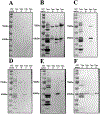A serological assay to detect and differentiate rodent exposure to soft tick and hard tick relapsing fever infections in the United States
- PMID: 36965260
- PMCID: PMC10956445
- DOI: 10.1016/j.ttbdis.2023.102167
A serological assay to detect and differentiate rodent exposure to soft tick and hard tick relapsing fever infections in the United States
Abstract
Human cases of relapsing fever (RF) in North America are caused primarily by Borrelia hermsii and Borrelia turicatae, which are spread by argasid (soft) ticks, and by Borrelia miyamotoi, which is transmitted by ixodid (hard) ticks. In some regions of the United States, the ranges of the hard and soft tick RF species are known to overlap; in many areas, recorded ranges of RF spirochetes overlap with Lyme disease (LD) group Borrelia spirochetes. Identification of RF clusters or cases detected in unusual geographic localities might prompt public health agencies to investigate environmental exposures, enabling prevention of additional cases through locally targeted mitigation. However, exposure risks and mitigation strategies differ among hard and soft tick RF, prompting a need for additional diagnostic strategies that differentiate hard tick from soft tick RF. We evaluated the ability of new and previously described recombinant antigens in serological assays to differentiate among prior exposures in mice to LD, soft or hard tick RF spirochetes. We extracted whole-cell protein lysates from RF Borrelia cultures and synthesized six recombinant RF antigens (Borrelia immunogenic protein A (BipA) derived from four species of RF Borrelia, glycerophosphodiester phosphodiesterase (GlpQ), and Borrelia miyamotoi membrane antigen A (BmaA)) to detect reactivity in laboratory derived (Peromyscus sp. and Mus sp.) mouse serum infected with RF and LD Borrelia species. Among 44 Borrelia exposed mouse samples tested, all five mice exposed to LD spirochetes were correctly differentiated from the 39 mice exposed to RF Borrelia using the recombinant targets. Of the 39 mice exposed to RF spirochetes, 28 were accurately categorized to species of exposure (71%). Segregation among soft tick RF species (Borrelia hermsii, Borrelia parkeri and Borrelia turicatae) was inadequate (58%) owing to observed cross-reactivity among recombinant BipA protein targets. However, among the 28 samples accurately separated to species, all were accurately assigned to soft tick or hard tick RF type. Although not adequately specific to accurately categorize exposure to soft tick RF species, the recombinant BipA protein targets from soft and hard tick RF species show utility in accurately discriminating mouse exposures to LD or RF Borrelia, and accurately segregate hard tick from soft tick RF Borrelia exposure.
Keywords: Borrelia; Recombinant proteins; Relapsing fever; Serology.
Copyright © 2023. Published by Elsevier GmbH.
Figures


Similar articles
-
Characterization of Immunological Responses to Borrelia Immunogenic Protein A (BipA), a Species-Specific Antigen for North American Tick-Borne Relapsing Fever.Microbiol Spectr. 2022 Jun 29;10(3):e0172221. doi: 10.1128/spectrum.01722-21. Epub 2022 May 17. Microbiol Spectr. 2022. PMID: 35579456 Free PMC article.
-
Borrelia miyamotoi BipA-like protein, BipM, is a candidate serodiagnostic antigen distinguishing between Lyme disease and relapsing fever Borrelia infections.Ticks Tick Borne Dis. 2024 May;15(3):102324. doi: 10.1016/j.ttbdis.2024.102324. Epub 2024 Feb 16. Ticks Tick Borne Dis. 2024. PMID: 38367587
-
Sequence analysis and serological responses against Borrelia turicatae BipA, a putative species-specific antigen.PLoS Negl Trop Dis. 2013 Sep 19;7(9):e2454. doi: 10.1371/journal.pntd.0002454. eCollection 2013. PLoS Negl Trop Dis. 2013. PMID: 24069498 Free PMC article.
-
Historical overview and update on relapsing fever group Borrelia in Latin America.Parasit Vectors. 2022 Jun 8;15(1):196. doi: 10.1186/s13071-022-05289-5. Parasit Vectors. 2022. PMID: 35676728 Free PMC article. Review.
-
Borrelia miyamotoi infection in nature and in humans.Clin Microbiol Infect. 2015 Jul;21(7):631-9. doi: 10.1016/j.cmi.2015.02.006. Epub 2015 Feb 18. Clin Microbiol Infect. 2015. PMID: 25700888 Free PMC article. Review.
References
-
- Armstrong BA, Kneubehl A, Krishnavajhala A, Wilder HK, Boyle W, Wozniak E, Phillips C, Hollywood K, Murray KO, Donaldson TG, Teel PD, Waldrup K, Lopez JE, 2018. Seroprevalence for the tick-borne relapsing fever spirochete Borrelia turicatae among small and medium sized mammals of Texas. PLOS Negl. Trop. Dis 12 (10), e0006877 10.1371/journal.pntd.0006877. Oct 29. - DOI - PMC - PubMed
-
- Barbour AG, Bunikis J, Travinsky B, Hoen AG, Diuk-Wasser MA, Fish D, Tsao JI, 2009. Niche partitioning of Borrelia burgdorferi and Borrelia miyamotoi in the same tick vector and mammalian reservoir species. Am. J. Trop. Med. Hyg 81 (6), 1120–1131. 10.4269/ajtmh.2009.09-0208. Dec. - DOI - PMC - PubMed
MeSH terms
Substances
Supplementary concepts
Grants and funding
LinkOut - more resources
Full Text Sources
Medical
Research Materials

